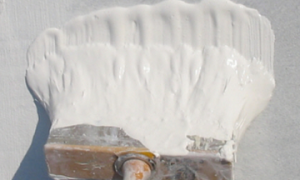
Can you imagine spraying an insulating paint in place of interior framing and traditional insulation methods? Talk about compelling. This chapter of the project describes the research that I went through to confirm whether or not insulating coatings for shipping container homes works for my application. The good news is we came to a conclusion. It is much better to reach a clear conclusion with supporting mathematics than it would have been to proceed on hope and faith.
4 Steps to Reaching a Definitive Conclusion on Insulating Coatings and Whether they live up to their Manufacturer’s Promise
1. Web based research
The first step in my research was a thorough and time consuming Internet search. This included finding the complete set of insulating coating product manufacturers, reviewing their product promises, and their application recommendations. There were very few companies that even passed the sniff test to be worthy of consideration. I read through countless blogs from marine enthusiast clubs to other shipping container housing projects to see what others have experienced. The result of this research was a lot of skepticism.
2. Direct contact with suppliers
I had different levels of contact with each supplier. I started with email contact with three suppliers. I proceeded to telephone conversations with reps and I even went as far as meeting representatives in Houston, Texas.
3. Doing the math
The usual questions and answers around insulating values are centered on R values. I was unable to get satisfactory answers regarding R value for insulating coatings so I changed my angle of questioning towards the raw building block of “Heat Loss” calculations. I specified my desired study condition and requested the technical engineering folks to provide me with raw heat loss calculations based on various recommended thickness levels of their insulating coating applications. Heat loss calculations came in the form of BTU loss per hour per square foot of surface area (btu/hr – sqft, or btu/sqft – hr). By asking this more technical question, I was able to get more direct and raw technical answers that weren’t masked with a bunch of arm waving and marketing lingo.
4. Bench scale testing
This would have been my final test to confirm whether the math held true, before building insulating coatings into my construction design work. But since the math was not attractive, I did not proceed to this step. I was very near moving to this step, in hopes and anticipation of promising math. The bench scale test was going to involve the construction of test boxes made of steel. Several test boxes of identical size and material would be built from off the shelf cold air return HVAC ducting materials given it is cost effective and readily available at the local HVAC shop. The boxes were likely going to be sized about 2’ square. Each box was going to be outfitted with a standard light fixture on the inside for creating a consistent heat source for all boxes.
There’s justification for skepticism on insulating coatings for shipping container homes.
Based on my raw calculations the most promising suppliers provided, in cooler climates insulating coatings simply perform poorly.
Insulating coatings applied per the manufacturer’s recommendations have 8x the heat loss of more traditional 2″ of closed cell spray foam for colder climates. No wonder all the skepticism online and good thing I was forewarned that it just might be too good to be true that an actual solution to not having to frame the inside of shipping container homes exists.
For more information on my findings, drop me an email or buy our DIY Shipping Container Cabin kit.
We had ours sprayed with fireproof purple foam by a contractor. This also had the effect of bonding the wooden laths. Good luck with your wonderful project!
Ade
Thanks for the comment Ade. Good point on the bonding effect. Once the spray foam is applied it would create a strong bridge between any studs or strapping. Do you have any photos of your project that you can share?
Jason
The shipping container concept has intrigued me for years. We are currently doing some research to actually “take the next step”! I have read that in colder climes, insulating the inside of the container contributes to condensation. What do you know about outside insulation with or without siding?
Thanks for any help.
Great question, and congrats on your efforts to build a container project!
I believe that you can certainly successfully design a project with outside insulation and cladding as long as you are keeping the place climate controlled 24/7. This way you are keeping the full steel structure warm. The key is to ensure there are proper “thermal breaks” in your design, otherwise you will create problems with frozen metal exposed to the outside which crosses into the warm interior space.
Let us know if we can help with your project in any way.
Jason